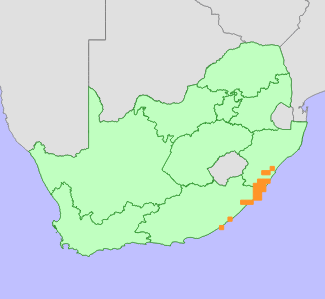|
Scientific Name | Isoglossa ovata (Nees) Lindau |
Higher Classification | Dicotyledons |
Family | ACANTHACEAE |
Synonyms | Isoglossa bachmannii Lindau, Rhytiglossa ovata Nees |
National Status |
Status and Criteria | Least Concern |
Assessment Date | 2017/08/25 |
Assessor(s) | L. von Staden |
Justification | Isoglossa ovata is a widespread and still relatively common species that is threatened by ongoing habitat loss and degradation across its range. It has an extent of occurrence (EOO) of 18 792 km². It is not yet in danger of extinction, but needs to be monitored. It is listed as Least Concern. |
Distribution |
Endemism | South African endemic |
Provincial distribution | Eastern Cape, KwaZulu-Natal |
Range | This species is endemic to South Africa, and occurs in the Eastern Cape and KwaZulu-Natal coastal areas between East London and Inanda. |
Habitat and Ecology |
Major system | Terrestrial |
Major habitats | Scarp Forest, Pondoland-Ugu Sandstone Coastal Sourveld, KwaZulu-Natal Coastal Belt Grassland, Transkei Coastal Belt, Northern Coastal Forest, Hamburg Dune Thicket, KwaZulu-Natal Coastal Belt Thornveld, Umtiza Forest Thicket, Southern Coastal Forest, South Eastern Coastal Thornveld, Dry Coast Hinterland Grassland, Moist Coast Hinterland Grassland, KwaZulu-Natal Hinterland Thornveld, KwaZulu-Natal Sandstone Sourveld, Eastern Valley Bushveld, Southern Mistbelt Forest |
Description | It occupies in rocky coastal grasslands and forest margins, predominantly on sandstone. |
Threats |
| At least 45% of this species' coastal grassland habitat has been lost to urban expansion, coastal development, timber plantations and sugarcane cultivation. Habitat loss continues across its range, and it has lost an estimated 5% over 24 years (1990-2014). Subpopulations in forest margins are threatened by competition from alien invasive plants, and large areas of coastal grasslands are degraded due to overgrazing. |
Population |
Isoglossa ovata is widespread and known from at least 30 locations. Due to ongoing habitat loss and degradation across its range, the population is declining, but not at a rate significant enough to reach a 30% population reduction in three generations.
|
Population trend | Decreasing |
Assessment History |
Taxon assessed |
Status and Criteria |
Citation/Red List version | | Isoglossa ovata (Nees) Lindau | Least Concern | Raimondo et al. (2009) | |
Bibliography |
Balkwill, K., Sebola, R.J. and Poriazis, D.L. 2017. Taxonomic revision of white-flowered Isoglossa Oerst. (Acanthaceae) in southern Africa. South African Journal of Botany 108:48-80.
Clarke, C.B. 1901. Acanthaceae. In: W.T. Thiselton-Dyer (ed). Flora Capensis V Section I (Acanthaceae-Proteaceae):1-92. Lovell Reeve & Co., Ltd., London.
Raimondo, D., von Staden, L., Foden, W., Victor, J.E., Helme, N.A., Turner, R.C., Kamundi, D.A. and Manyama, P.A. 2009. Red List of South African Plants. Strelitzia 25. South African National Biodiversity Institute, Pretoria.
|
Citation |
| von Staden, L. 2017. Isoglossa ovata (Nees) Lindau. National Assessment: Red List of South African Plants version 2024.1. Accessed on 2025/11/13 |
 Comment on this assessment
Comment on this assessment


